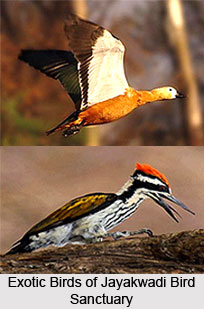 Jaikwadi Wildlife Sanctuary, located in Aurangabad and Ahmednagar districts of the Indian state Maharashtra, is the home to diverse species of flora and fauna. The sanctuary also hosts an enchanting array of birds. It spreads across the backwaters of Nathsagar Lake. Nathsagar Lake, a shallow saucer type water body, was created long back in a huge water reservoir and includes 26 islands along with a long shoreline. The surrounding regions of the lake comprise agricultural lands and irrigated fields which provide an excellent habitat for flora and fauna. A number of native as well as more than 70 species of migratory birds are the inhabitants of the sanctuary. The place was declared as a wildlife sanctuary in the year 1986. The biodiversity of the sanctuary is supported greatly by Jaikwadi Dam also known as Paithan Dam, which stands over the sacred Godavari River in the year 1973.
Jaikwadi Wildlife Sanctuary, located in Aurangabad and Ahmednagar districts of the Indian state Maharashtra, is the home to diverse species of flora and fauna. The sanctuary also hosts an enchanting array of birds. It spreads across the backwaters of Nathsagar Lake. Nathsagar Lake, a shallow saucer type water body, was created long back in a huge water reservoir and includes 26 islands along with a long shoreline. The surrounding regions of the lake comprise agricultural lands and irrigated fields which provide an excellent habitat for flora and fauna. A number of native as well as more than 70 species of migratory birds are the inhabitants of the sanctuary. The place was declared as a wildlife sanctuary in the year 1986. The biodiversity of the sanctuary is supported greatly by Jaikwadi Dam also known as Paithan Dam, which stands over the sacred Godavari River in the year 1973.
Flora of Jaikwadi Wildlife Sanctuary
Jaikwadi Wildlife Sanctuary is inhabited by a number of aquatic species of plants such as Vallisneria, Potamogeton, Hydrilla, Spyrogyra, Chara and others. The surrounding areas have Ipomea fistulosa and Argemone maxicana in abundance.
Fauna of Jaikwadi Wildlife Sanctuary
Jaikwadi Wildlife Sanctuary is the abode of a vast variety of fauna. About 200 species of birds can be spotted here out of which more than 70 species are migratory. In the sanctuary migratory birds arrive from Siberia, Uzbekistan, Europe, Central Asia and many other regions since ages. Some of the species of migratory birds are found abundant in number. Common avifauna of the sanctuary include Glossy Ibis, God Wit, Shovellar, Wigeon, Pintails, Pochards Teals, Brahmany Duck, Flamingos, Domicile Cranes and others. The place serves as a heaven for bird watchers. About 50 species of fishes also dwell in this region.
Sant Gyaneshwar Udyan
Jaikwadi Wildlife Sanctuary is also famed for sheltering a large garden named Sant Gyaneshwar Udyan. Encompassing an area of more than 124 hectares, it is reputed as the largest garden of Maharashtra. It has vibrant flowerbeds, forty thousand fruit trees, musical fountains and sprawling lawns. It also has a play area for children, boat rides and swimming pool which offer a refreshing time to the visitors.
Visiting Information
The best time to visit the sanctuary is from October to February. Aurangabad, located 50 kilometres away, is the nearest airport as well as railway station. It can also be reached conveniently through roadways.



















